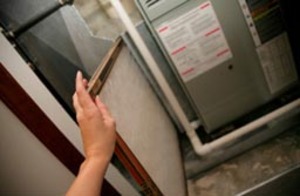With the price of energy always rising, even small changes in furnace efficiency can result in big savings. Your furnace accounts for the majority of energy used in your home; so if you are looking for ways to save on energy bills, start with your furnace. It will offer the largest savings for your household, and there are a few simple things you can do yourself to make your furnace operate at peak efficiency.
Check Your Filter
Very few people realize just how important a clean filter is to the efficiency of a home heating system. This is the simplest and most important task you can do yourself to make your furnace operate at its very best. A dirty filter increases the amount of work the blower motor in your furnace has to do in order to circulate air throughout your home. In other words, a dirty filter means more energy must be used to move warm air into your living area.
In addition, poor air circulation prevents efficient heat transfer from the heat exchanger to the air circulating through the furnace. Translation: Poor air circulation means poor heat transfer, which results in your furnace burning more fuel to heat less.
The rule of thumb is to replace your filter every 30 days. As for the type of filter to use, believe it or not, the cheaper filters are better. Here is why. The cheap filters (blue and cost about $1) offer less resistance to the blower in the furnace. The high-end filters, advertised as filtering more particles and lasting 60 to 90 days, are very dense and restrictive. Your blower has to work about three times harder to pull air through them, and unless your system is designed for these type filters, which most are not, the furnace will operate less efficiently. Also, (filter manufacturers don’t advertise this) using high-end filters can decrease the life of your furnace blower.
Check Your Heating Ducts for Leaks
Everyone knows the wonders of duct tape, but what most people don’t know is that the glue binders in duct tape break down after 5 to 10 years of being exposed to the high temperatures of heating ducts – then it starts leaking air. Leaking air is heated air that doesn’t make it into your living area. It’s wasted energy.
The best way to check your heating ducts for leaks is to remove all the insulation and feel around all the seams on the duct. This is not always practical, so the next best thing to do is turn your system on and set the thermostat about 10 degrees higher than the temperature in your home. Let the system run for several minutes and then feel for hot spots along the outside of the duct insulation. If the air leak is significant enough it will warm the insulation around the leak to a higher temperature than the rest of the insulation.
Once a leak is found, remove the insulation and re-seal the area with a high-grade duct tape. Then patch the insulation. You won’t find high-grade duct tape at your local hardware store or at larger home repair chains. Search your local listings for HVAC Distributors (also listed as Air Conditioning Equipment Wholesalers, or Heating Equipment). Find a local distributor and visit the store. Most won’t sell equipment to you unless you are a licensed installer, but they will sell you duct tape. Ask for a durable duct tape, or ask for mastic tape if you want a permanent sealer on your duct.
Have Your Furnace Serviced
Call a reputable heating company in your area and ask them to service your unit. It may sound expensive, but it’s worth it for several reasons. A certified heating technician can check the burners on your furnace and adjust the air to fuel ration on the burners, check and adjust the gas pressure at the furnace gas valve, and verify that everything is working efficiently and, more importantly, safely.
This is not something the average do-it-yourself homeowner is qualified for, but it could save you hundreds of dollars over the course of a year if all your burners are operating properly. Also, it could save your life. A crack in the furnace heat exchanger can leak carbon monoxide into your home. A service technician can spot cracks before they become hazardous.
Set Your Thermostat Lower
It may sound obvious, but don’t underestimate how much you could save just by lowering your thermostat by 1 to 2 degrees. Depending on your area and utility rates, you could see savings of $10 to $30 per month just from lowering your thermostat a few degrees. Also, try lowering it 5 to 6 degrees at night and adding a few extra blankets to your bed. There’s no need to heat the whole house when you are lying motionless in one spot.
Upgrade Your Furnace
This is another one of those ideas that may sound like it is contrary to saving money; however, you could be eligible for a tax credit if you upgrade to a high-efficiency furnace. The tax credit could very well equal half the cost of replacement.
In addition, newer furnaces are sometimes 20 to 30 percent more efficient than furnaces made just 10 years ago. The furnace could, literally, pay for itself in just 3 to 5 years. And if you financed it, you could make the payments with the money you save each month on your power bill. In other words, it would be like getting a free furnace then after 5 years you would start pocketing the money saved.
Call at least 3 local heating companies and ask for a free estimate along with an energy cost analysis that compares the new system to your old system. If they don’t know how to do a cost analysis, then chances are they are not qualified. Keep calling until you find three who can.
Sources
“Heating,” American Council for Energy-Efficient Economy
“Furnaces and Boilers,” U.S. Department of Energy



